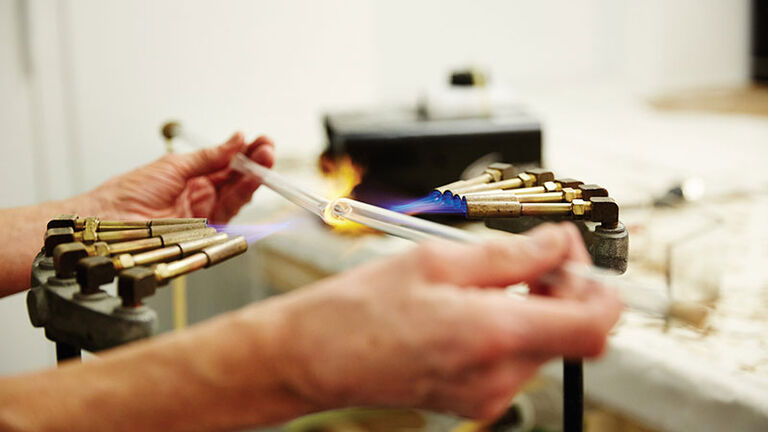
Undergraduate Overview
Art & Technology / Sound Practices Undergraduate Overview
Spring 2026 Application Deadline: December 1
Fall 2026 Early Action & Priority Merit Scholarship Deadline: November 15
The Department of Art & Technology / Sound Practices offers a wide variety of courses in the technological and sonic arts. It is a place to build skills, learn concepts, and ask questions through rigorous coursework with expert faculty who will support and challenge your investigations.
Each semester, AT/SP offers more than thirty undergraduate courses to choose from, covering topics that include creative coding, experimental sound production, virtual and augmented reality, game design, electronics and kinetics, software and hardware interface design, hacking and circuit bending, live sound and media performance, text interfacing with technology and sound, bio art, olfactory art, sound and media installation, light projection, acoustic ecology, sound for cinema, and many more.
Customize Your Education
Undergraduate students can plot their own pathway through the AT/SP curriculum in consultation with faculty and academic advisers. Introductory courses serve as a foundation for the wide range of upper-level studio courses focusing on skills, concepts, and topics relevant to an immersive and diverse education in the technological and sonic arts. This encourages an interdisciplinary approach that addresses the individual student's interests and at the same time encourages their explorations into unfamiliar territories with unlimited creative possibilities.
Admissions Requirements and Curriculum
-
To apply to SAIC, you will need to fill out an application and submit your transcripts, artist's statement, and letters of recommendation. And most importantly, we require a portfolio of your best and most recent work—work that will give us a sense of you, your interests, and your willingness to explore, experiment, and think beyond technical art, design, and writing skills.
To apply, please submit the following items:
Bachelor of Fine Arts in Studio Portfolio
Submit 10–15 pieces of your best and most recent work. We will review your portfolio and application materials for merit scholarship once you have been admitted to SAIC.
When compiling a portfolio, you may concentrate your work in a single discipline or show work in a breadth of media. The portfolio may include drawings, prints, photographs, paintings, film, video, audio recordings, sculpture, ceramics, fashion designs, graphic design, furniture, objects, architectural designs, websites, video games, sketchbooks, scripts, storyboards, screenplays, zines, or any combination of the above.
Learn more about applying to SAIC's Bachelor of Fine Arts in Studio, or view our portfolio preparation guide for more information.
-
Studio 69 - CP 1010 Core Studio Practice I (3)
- CP 1011 Core Studio Practice II (3)
- CP 1020 Research Studio I (3)
- CP 1022 Research Studio II (3)
- SOPHSEM 2900 (3)
- PROFPRAC 39XX (3)
- CAPSTONE 49XX (3)
- Studio Electives (48)
Art History 15 - ARTHI 1001 World Cultures/Civilizations: Pre-History—19th Century Art and Architecture (3)
- Additional Art History Course at 1000-level (e.g., ARTHI 1002) (3)
- Art History Electives at 2000-, 3000-, or 4000-level (9)
Liberal Arts 30 - ENGLISH 1001 First Year Seminar I (3)
- ENGLISH 1005 First Year Seminar II (3)
- Natural Science (6)
- Social Science (6)
- Humanities (6)
- Liberal Arts Electives (6)
- Any of the above Liberal Arts or certain AAP or EIS
General Electives 6 - Studio, Art History, Liberal Arts, AAP, or EIS
Total Credit Hours 120 * BFA students must complete at least two classes designated as "off campus study." These classes can also fulfill any of the requirements listed above and be from any of the divisions (Art History, Studio, Liberal Arts, or General Electives).
BFA in Studio with Thesis Option (Liberal Arts or Visual Critical Studies): Students interested in pursuing the BFA in Studio with the Thesis Option (Liberal Arts or Visual Critical Studies) should contact their academic advisor for details about eligibility, program requirements, and the application process.
Total credits required for minimum residency 66 Minimum Studio credit 42
Course Listing
Upcoming Admissions Events
Meet with us, learn more about SAIC and our curriculum, and get feedback on your work. LEARN MORE.
Get More Info
Sign up for email updates to learn more about our undergraduate programs.